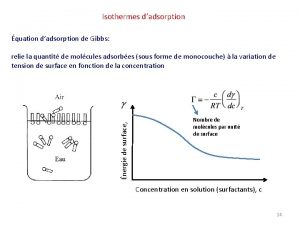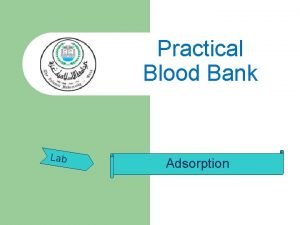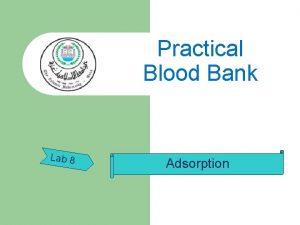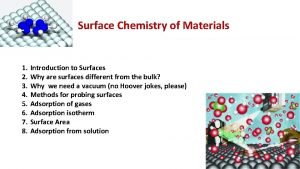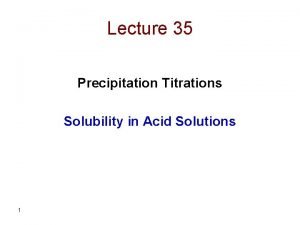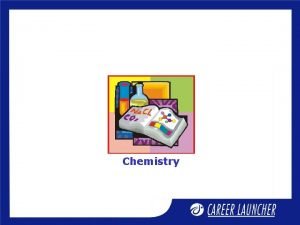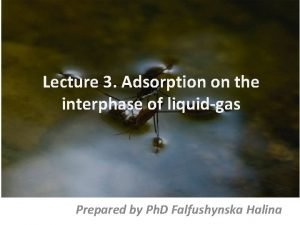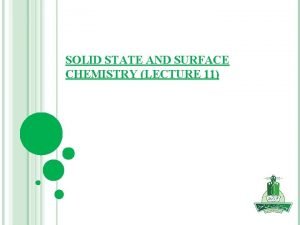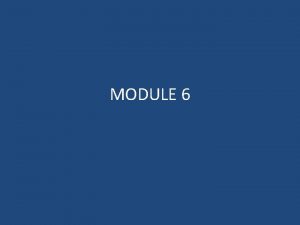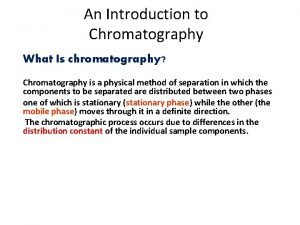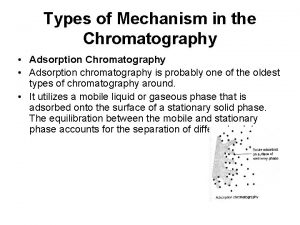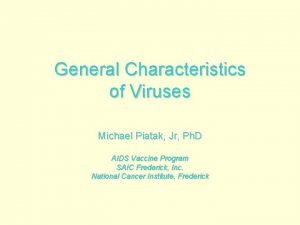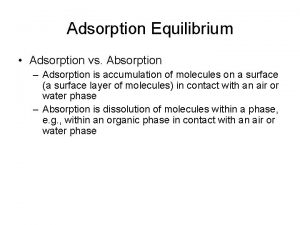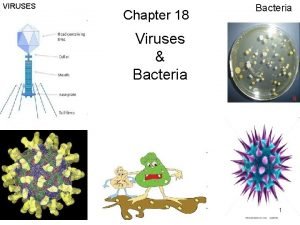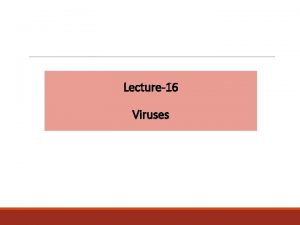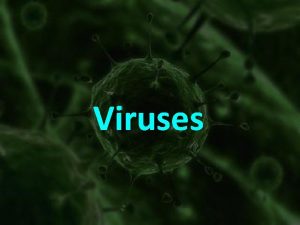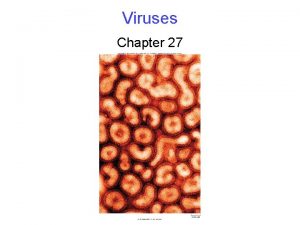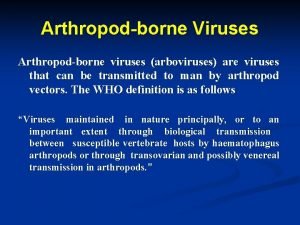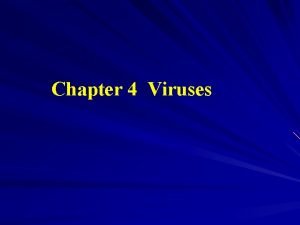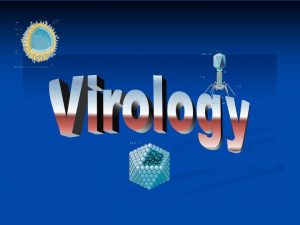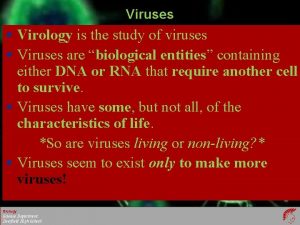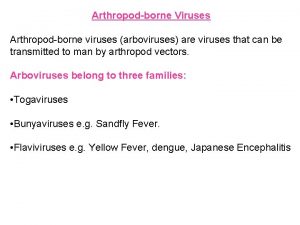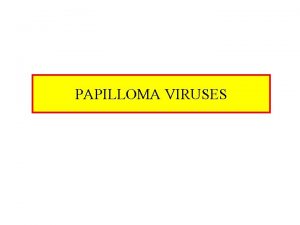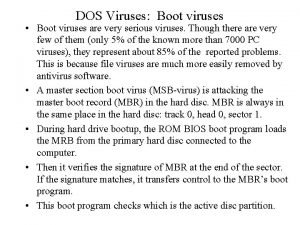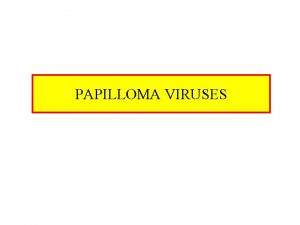Multiplication Cycles in Animal Viruses Adsorption Penetration Uncoating





























- Slides: 29

Multiplication Cycles in Animal Viruses • • • Adsorption Penetration Uncoating Synthesis Assembly Release

Adsorption • Virus encounters susceptible host cells • Adsorbs specifically to receptor sites on the cell membrane • Because of the exact fit required, viruses have a limited host range

Figure 6. 12

Penetration • Flexible cell membrane of the host is penetrated by the whole virus or its nucleic acid • Endocytosis: entire virus engulfed by the cell and enclosed in a vacuole or vesicle • The viral envelope can also directly fuse with the host cell membrane

Figure 6. 13

Uncoating • Enzymes in the vacuole dissolve the envelope and capsid • The virus is now uncoated

Synthesis • Free viral nucleic acid exerts control over the host’s synthetic and metabolic machinery • DNA viruses- enter host cell’s nucleus where they are replicated and assembled – DNA enters the nucleus and is transcribed into RNA – The RNA becomes a message for synthesizing viral proteins (translation) – New DNA is synthesized using host nucleotides • RNA viruses- replicated and assembled in the cytoplasm

Assembly • Mature virus particles are constructed from the growing pool of parts

Release • Nonenveloped and complex viruses are released when the cell lyses or ruptures • Enveloped viruses are liberated by budding or exocytosis • Anywhere from 3, 000 to 100, 000 virions may be released, depending on the virus • Entire length of cycle- anywhere from 8 to 36 hours

Figure 6. 15

Damage to the Host Cell and Persistent Infections • Cytopathic effects- virus-induced damage to the cell that alters its microscopic appearance • Inclusion bodies- compacted masses of viruses or damaged cell organelles

Figure 6. 16


• Important for the diagnosis of viral infections • Some viral infections maintain a carrier relationship – The cell harbors the virus and is not immediately lysed – Persistent infections- from a few weeks to the remainder of the host’s life • Some viruses remain in a chronic latent state, periodically becoming activated • Some viruses enter their host cell and permanently alter its genetic material, leading to cancer – Oncogenic viruses – Their effect is called transformation – Oncoviruses- mammalian viruses capable of initiating tumors

Viruses that Infect Bacteria • Bacteriophage • Most contain ds. DNA • Often make the bacteria they infect more pathogenic for humans

T-even Phages • • Icosahedral capsid head containing DNA Central tube surrounded by a sheath Collar Base plate Tail pins Fibers Similar stages as animal viruses – Adsorb to host bacteria – The nucleic acid penetrates the host after being injected through a rigid tube inserted through the bacterial membrane and wall – Entry of the nucleic acid causes the cessation of host cell DNA replication and protein synthesis – The host cell machinery is then used for viral replication and synthesis of viral proteins – As the host cell produces new parts, they spontaneously assemble

Figure 6. 17

Figure 6. 18

Figure 6. 19

Lysogeny: The Silent Virus Infection • Temperate phages- special DNA phages that undergo adsorption and penetration but are not replicated or released immediately • Instead the viral DNA enters an inactive prophage stage • Lysogeny: the cell’s progeny will also have the temperate phage DNA • Lysogenic conversion: when a bacterium acquires a new trait from its temperate phage

Figure 6. 20


Techniques in Cultivating and Identifying Animal Viruses • Primary purposes of viral cultivation – To isolate and identify viruses in clinical specimens – To prepare viruses for vaccines – To do detailed research on viral structure, multiplication cycles, genetics, and effects on host cells • Using Live Animal Inoculation – Specially bred strains of white mice, rats, hamsters, guinea pigs, and rabbits – Occasionally invertebrates or nonhuman primates are used – Animal is exposed to the virus by injection • Using Bird Embryos – Enclosed in an egg- nearly perfect conditions for viral propagation – Chicken, duck, and turkey are most common – Egg is injected through the shell using sterile techniques

Figure 6. 21

Using Cell (Tissue) Culture Techniques • Most viruses are propagated in some sort of cell culture • The cultures must be developed and maintained • Animal cell cultures are grown in sterile chambers with special media • Cultured cells grow in the form of a monolayer • Primary or continuous

Figure 6. 22

Medical Importance of Viruses • Most common cause of acute infections that do not result in hospitalization • Most do not cause death but those that do can have very high mortality rates • Others can lead to long-term debility

Other Noncellular Infectious Agents • Spongiform encephalopathies – Chronic, persistent diseases – Long period of latency – Deposition of protein fibrils in the brain tissue- prions • Satellite viruses – Defective forms of viruses – Dependent on other viruses for replication • Viroids – Parasitize plants – Very small – Composed only of naked strands of RNA

Treatment of Animal Viral Infections • Because they are not bacteria, antibiotics are ineffective • Antiviral drugs block virus replication by targeting one of the steps in the viral life cycle • Interferon shows potential for treating and preventing viral infections • Vaccines stimulate immunity
 Unlike lytic viruses lysogenic viruses do not
Unlike lytic viruses lysogenic viruses do not /watch?v=dckvspcd8gs
/watch?v=dckvspcd8gs Multiplication of cycles
Multiplication of cycles Les types d'adsorption
Les types d'adsorption Adsorption blood bank
Adsorption blood bank Adsorption technique in blood banking
Adsorption technique in blood banking Freundlich adsorption isotherm formula
Freundlich adsorption isotherm formula Which detector used in hplc
Which detector used in hplc Adsorption column design
Adsorption column design Bet equation
Bet equation Dry gum and wet gum method
Dry gum and wet gum method Adsorption
Adsorption Accogel process of soft gelatin capsule
Accogel process of soft gelatin capsule Agscn dissociation
Agscn dissociation Positive adsorption
Positive adsorption Physisorption and chemisorption graph
Physisorption and chemisorption graph What is adsorption
What is adsorption What is adsorption in physical pharmacy
What is adsorption in physical pharmacy Adsorption introduction
Adsorption introduction Langmuir adsorption isotherm
Langmuir adsorption isotherm Langmuir adsorption isotherm
Langmuir adsorption isotherm Partition chromatography
Partition chromatography Adsorption system
Adsorption system Fajans titration
Fajans titration Introduction chromatography
Introduction chromatography Mechanism of adsorption chromatography
Mechanism of adsorption chromatography Occlusion in gravimetric analysis
Occlusion in gravimetric analysis Nonliving particle that replicates inside a living cell
Nonliving particle that replicates inside a living cell Charateristics of viruses
Charateristics of viruses Viruses video
Viruses video



